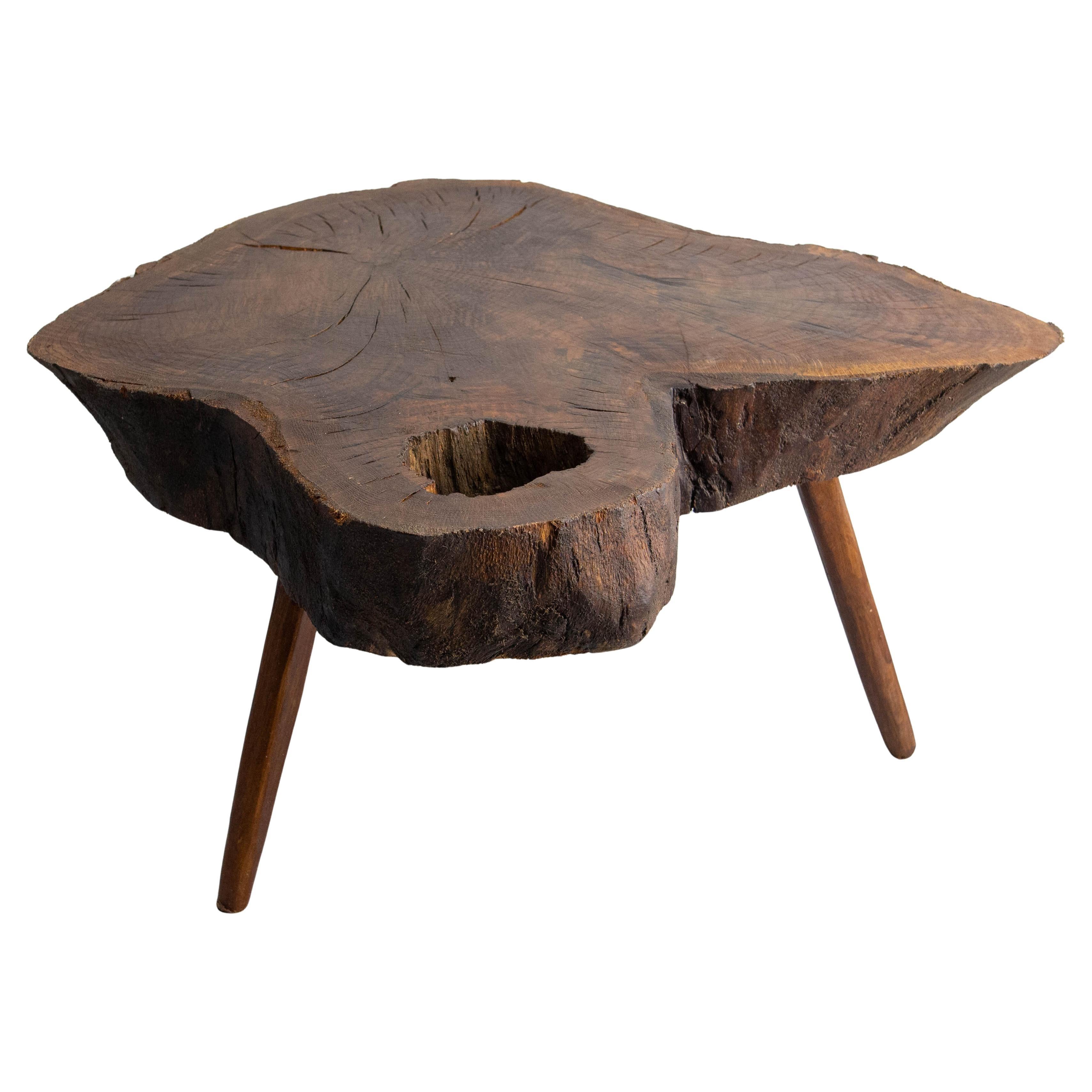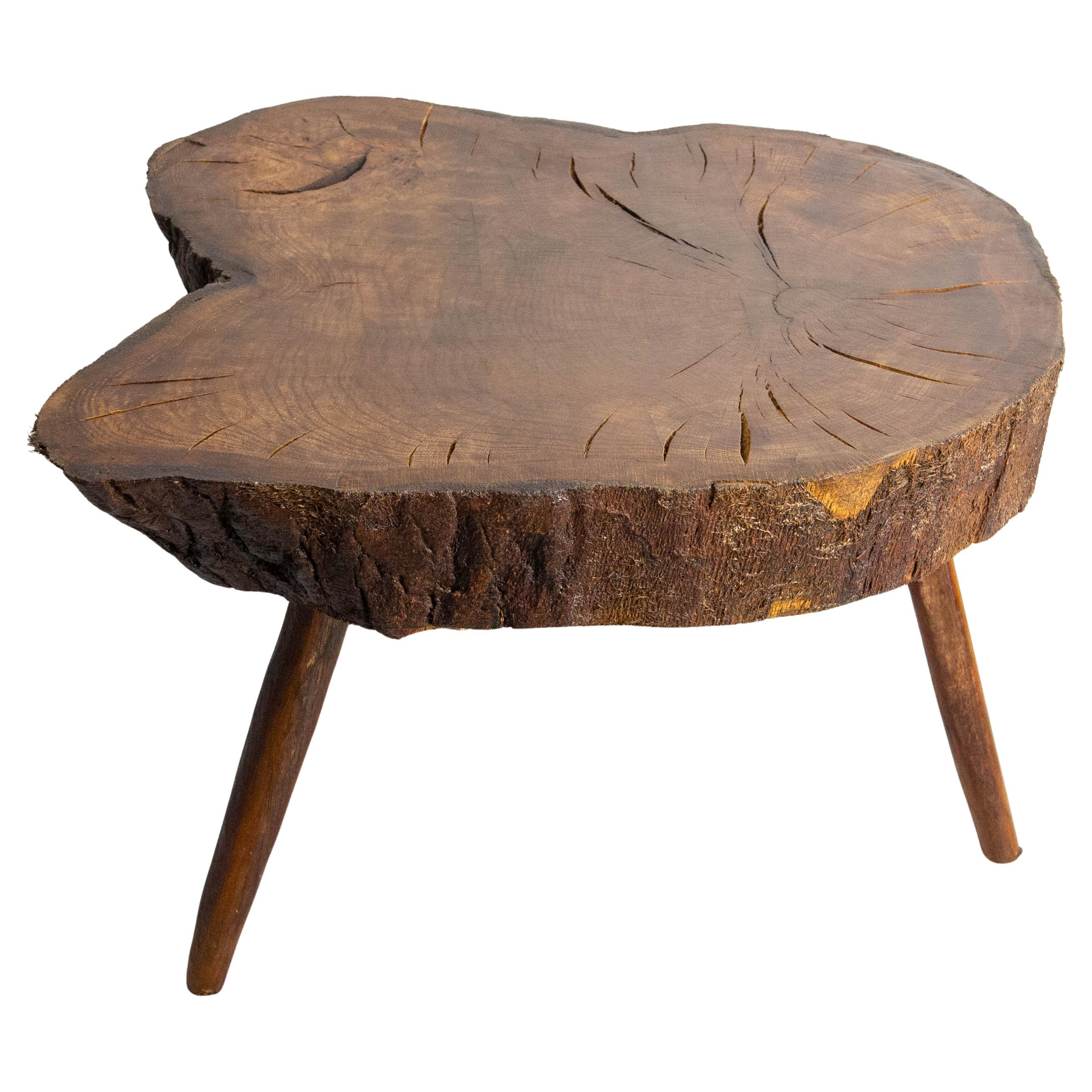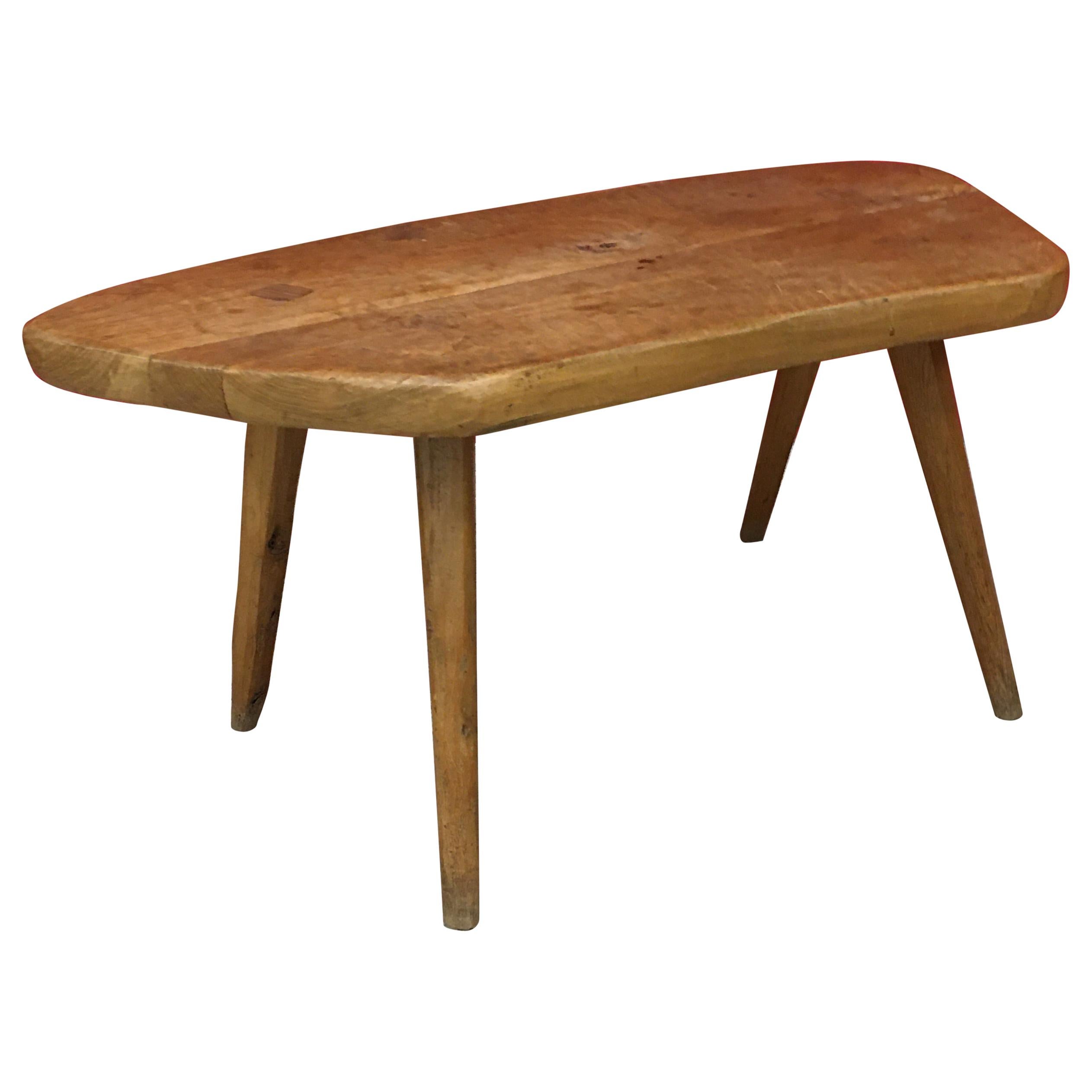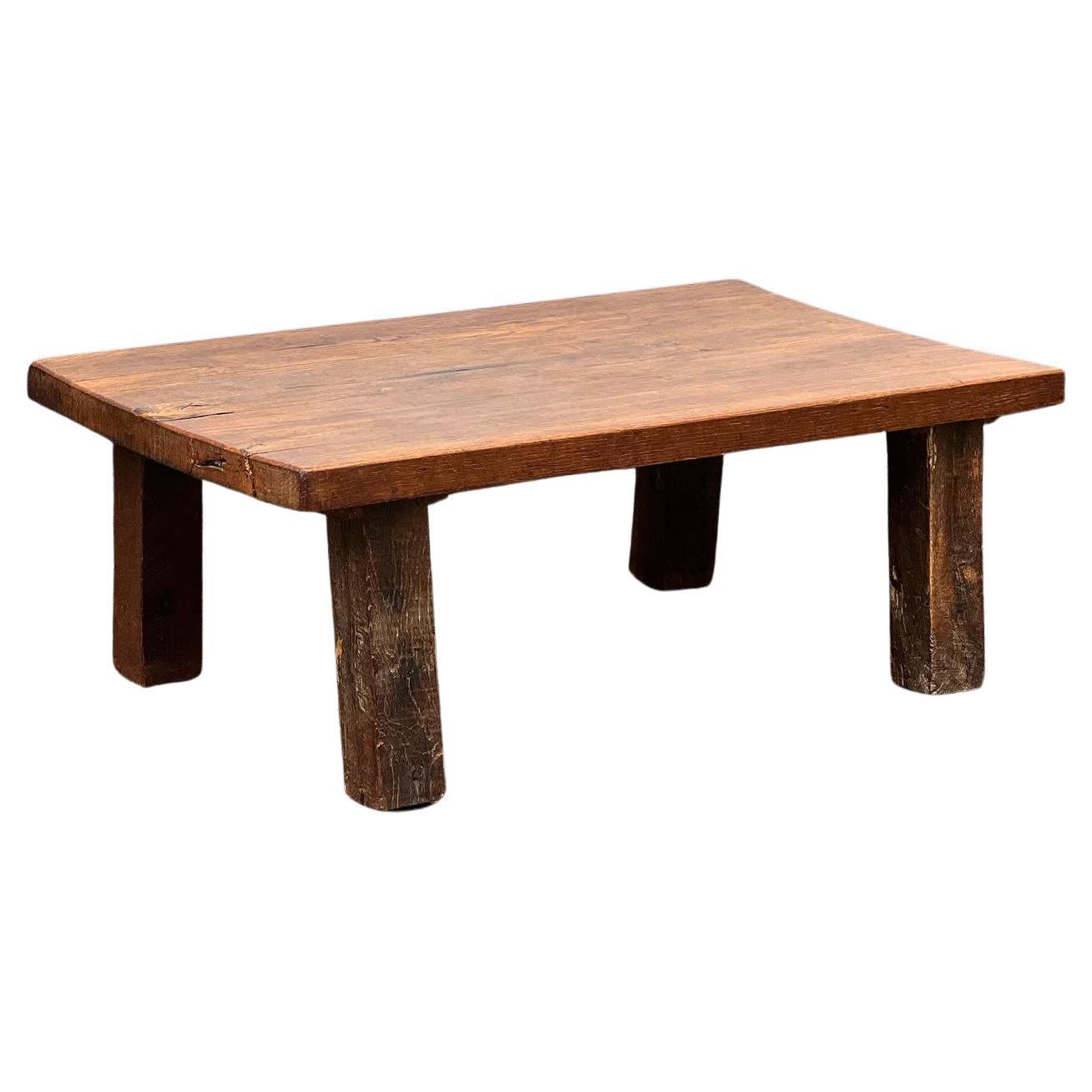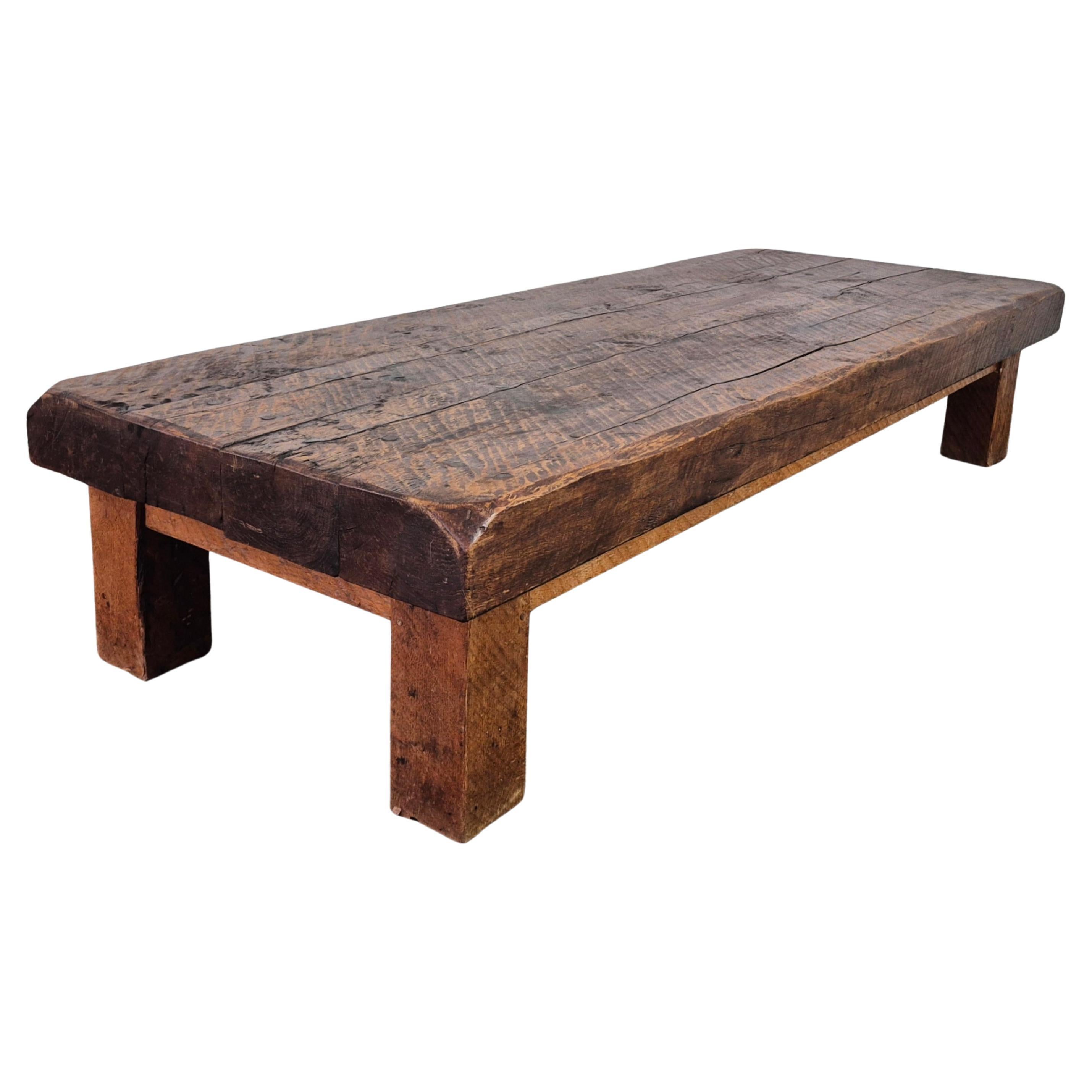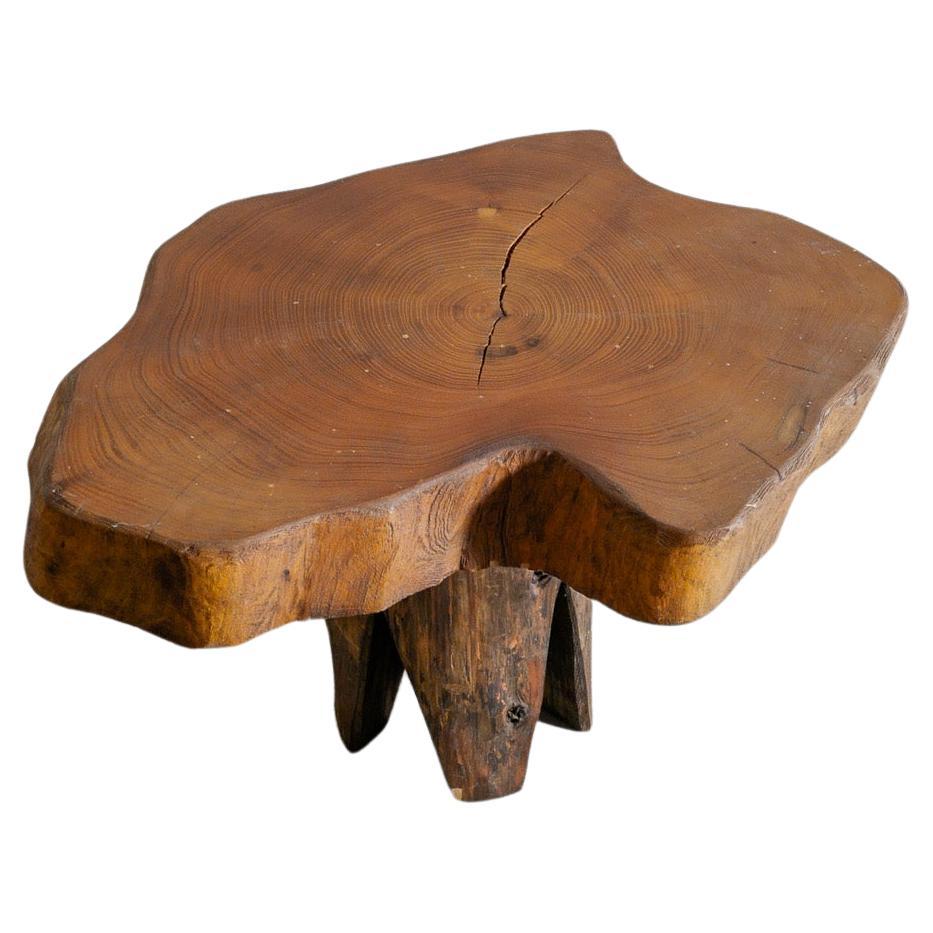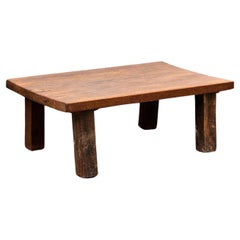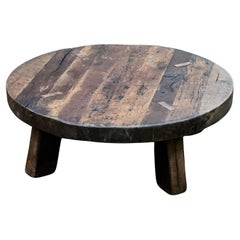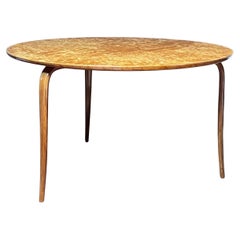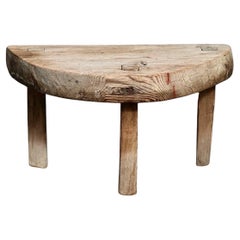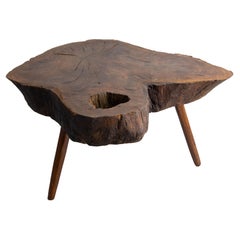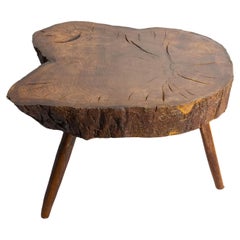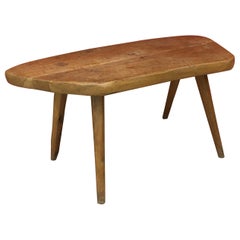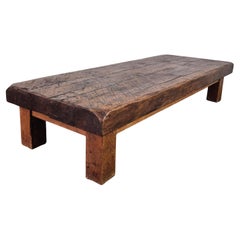Items Similar to French Brutalist Oak Coffee Table, Freeform, 1950s, Handmade
Want more images or videos?
Request additional images or videos from the seller
1 of 6
French Brutalist Oak Coffee Table, Freeform, 1950s, Handmade
$3,104.10
£2,309.77
€2,610
CA$4,264.86
A$4,759.95
CHF 2,504.28
MX$57,820.30
NOK 31,747.59
SEK 29,711.77
DKK 19,868.93
About the Item
Very unique oak handmade massive slay of tree. It is a free form shape. The top is patinated and shows various shades of brown/brownish colors and honey tones. Elegant and brutalist describe that table properly. The height is 31.5 cm and is 86 cm x 66 cm. Very strong table. Lovely as a side table, a coffee table or a stand for a sculpture.
--------------------------------------------------------------------------------------------------------------------
Brutalist architecture is an architectural style that emerged during the 1950s in the United Kingdom, among the reconstruction projects of the post-war era. Brutalist buildings are characterised by minimalist constructions that showcase the bare building materials and structural elements over decorative design. The style commonly makes use of exposed, unpainted concrete or brick, angular geometric shapes and a predominantly monochrome colour palette; other materials, such as steel, timber, and glass, are also featured.
Descending from the modernist movement, brutalism is said to be a reaction against the nostalgia of architecture in the 1940s. Derived from the Swedish phrase nybrutalism, the term "new brutalism" was first used by British architects Alison and Peter Smithson for their pioneering approach to design. The style was further popularised in a 1955 essay by architectural critic Reyner Banham, who also associated the movement with the French phrases béton brut ("raw concrete") and art brut ("raw art"). The style, as developed by architects such as the Smithsons, Hungarian-born Erno Goldfinger, and the British firm Chamberlin, Powell & Bon, was partly foreshadowed by the modernist work of other architects such as French-Swiss Le Corbusier, Estonian-American Louis Kahn, German-American Mies van der Rohe, and Finnish Alvar Aalto.
In the United Kingdom, brutalism was featured in the design of utilitarian, low-cost social housing influenced by socialist principles and soon spread to other regions around the world. Brutalist designs became most commonly used in the design of institutional buildings, such as universities, libraries, courts, and city halls. The popularity of the movement began to decline in the late 1970s, with some associating the style with urban decay and totalitarianism.
Brutalism has been polarising historically; specific buildings, as well as the movement as a whole, have drawn a range of criticism (often being described as "cold" or "soulless") but have also elicited support from architects and local communities (with many brutalist buildings having become cultural icons, sometimes obtaining listed status). In recent decades, the movement has become a subject of renewed interest. In 2006, several Bostonian architects called for a rebranding of the style to "heroic architecture" to distance it from the negative connotations of the term "brutalism".
- Similar to:José Zanine Caldas (Artist)
- Dimensions:Height: 12.41 in (31.5 cm)Width: 32.29 in (82 cm)Depth: 25.99 in (66 cm)
- Style:Brutalist (In the Style Of)
- Materials and Techniques:
- Place of Origin:
- Period:
- Date of Manufacture:1950's
- Condition:Wear consistent with age and use. Minor fading.
- Seller Location:Forest, BE
- Reference Number:1stDibs: LU8186234550182
About the Seller
5.0
Vetted Professional Seller
Every seller passes strict standards for authenticity and reliability
Established in 2007
1stDibs seller since 2023
32 sales on 1stDibs
Typical response time: <1 hour
- ShippingRetrieving quote...Shipping from: Forest, Belgium
- Return Policy
Authenticity Guarantee
In the unlikely event there’s an issue with an item’s authenticity, contact us within 1 year for a full refund. DetailsMoney-Back Guarantee
If your item is not as described, is damaged in transit, or does not arrive, contact us within 7 days for a full refund. Details24-Hour Cancellation
You have a 24-hour grace period in which to reconsider your purchase, with no questions asked.Vetted Professional Sellers
Our world-class sellers must adhere to strict standards for service and quality, maintaining the integrity of our listings.Price-Match Guarantee
If you find that a seller listed the same item for a lower price elsewhere, we’ll match it.Trusted Global Delivery
Our best-in-class carrier network provides specialized shipping options worldwide, including custom delivery.More From This Seller
View AllFrench Brutalist Oak Coffee Table, in the style of Pierre Chapo, 1950s, Handmade
By Pierre Chapo
Located in Forest, BE
Very unique oak handmade massive slays of tree. The top is patinated and shows various shades of brown/brownish colors and honey tones. Elegant and brutalist describe that table properly. The height is 31.5 cm and is 86 cm x 66 cm. Very strong table. Lovely coffee table.
--------------------------------------------------------------------------------------------------------------------
Pierre Chapo est né dans le 19e arrondissement de Paris, mais en 1937 la famille s'installe à Vierzon, dans le Cher, le jeune homme s'essaie à la peinture. Puis rencontre en 1947 un charpentier de marine; dans son atelier il découvre le travail du bois, et décide de s'inscrire à l'École nationale supérieure des beaux-arts, section architecture avec Henri Larrieu et Louis Aublet. Les études sont entrecoupées de voyages vers les pays scandinaves, du service militaire en Allemagne, ainsi que d'un périple d'un an en Amérique centrale et un stage dans un cabinet d'architectes en Arizona.
De retour en France, Pierre Chapo poursuit le travail du bois essentiellement le chêne, le frêne et l'orme massif qu'il articule avec le double intérêt qu'il porte au design contemporain et au savoir-faire de l'artisanat traditionnel. Après quelques années, il ouvre une galerie boulevard de l'Hôpital, où il expose ses réalisations ainsi que celles d'autres créateurs comme Isamu Noguchi avec lequel il partage une approche sculpturale et organique, il reçoit ses premières commandes parmi lesquelles un lit simple demandé par Samuel Beckett. En 1960, lors de l'exposition Arts et techniques de l'artisanat, son travail est reconnu par la ville de Paris dont il reçoit la Médaille d'or.
Puis c'est le développement de l'atelier de fabrication de meubles, à Clamart et la participation à plusieurs projets avec des fabricants et des aménagements avec différents architectes-maitres d’œuvre dont le travail de certains comme Charlotte Perriand pour la station des Arcs l’influencera6 et dont il éditera plus tard une table basse. En 1967, il expose au Salon des artistes décorateurs et remporte la Médaille de bronze de la Société d'encouragement à l'art et à l'industrie9. Cette même année, il s'installe à Gordes et y crée sa société et son usine qui vend et fabrique les meubles audacieux et robustes, en bois massif qu'il dessine, tout en conservant l'atelier de Clamart et la boutique de Paris, étendant son réseau avec des dépositaires à Bruxelles et dans plusieurs villes de France...
Category
Mid-20th Century French Brutalist Coffee and Cocktail Tables
Materials
Hardwood
$826 Sale Price
65% Off
Large French brutalist massive oak coffee table 130cm
Located in Forest, BE
This is a large and massive coffee table made out of railroad beams. Made in France around the 1950's. It's so strong that it will last forever. M...
Category
Vintage 1950s French Brutalist Coffee and Cocktail Tables
Materials
Oak
$2,497 Sale Price
50% Off
Bruno Mathsson rare original 1936 burl wood birch coffee table collector mint
By Firma Karl Mathsson, Bruno Mathsson
Located in Forest, BE
Table en loupe de bouleau complètement restaurée. Design de 1936 et produit en 1936 dans les ateliers de son père Karl Mathsson. Cette table est rare et est le plus grand format de l...
Category
Vintage 1930s Swedish Scandinavian Modern Side Tables
Materials
Birch
Swedish folk small wooden stool 18th/19th century Folk Art Peasant unique
By José Zanine Caldas, Axel Einar Hjorth
Located in Forest, BE
Unique Swedish small wooden stool made of massive pine circa the early/mid 1800. Lots of history, patina and traces of time. Very good condition. It’s a small one but a true eye cat...
Category
Antique Mid-18th Century Swedish Brutalist Stools
Materials
Pine
Bruno Mathsson rare original 1936 burl wood birch coffee table collector mint
By Bruno Mathsson, Firma Karl Mathsson
Located in Forest, BE
Table en loupe de bouleau complètement restaurée. Design de 1936 et produit en 1936 dans les ateliers de son père Karl Mathsson. Cette table est rare. Elle apporte de la chaleur par ...
Category
Vintage 1930s Swedish Scandinavian Modern Side Tables
Materials
Birch
Swedish folk meat chopping bench Dated late 1800 Folk Art Peasant Seating
By José Zanine Caldas, Axel Einar Hjorth
Located in Forest, BE
Unique Swedish meat chopping bench made of massive pine circa the late 1800. Lots of history, patina and traces of time. Very good condition. Remarkable as a side table in any room...
Category
Antique 19th Century Swedish Brutalist Stools
Materials
Pine
You May Also Like
French Brutalist Oak Coffee Table Three Legs, circa 1960
Located in Labrit, Landes
French midcentury coffee table made with the trunc of an oak tree. The hole in the top adds a note of authenticity to a piece already marked by its brutalist styling.
In good conditi...
Category
Mid-20th Century French Mid-Century Modern Coffee and Cocktail Tables
Materials
Oak
French Brutalist Oak Coffee Table Three Legs, circa 1960
Located in Labrit, Landes
French midcentury coffee table made with the trunc of an oak tree. The cracks in the wood and the bark still present contribute to the authenticity to a piece already marked by its b...
Category
Mid-20th Century French Mid-Century Modern Coffee and Cocktail Tables
Materials
Oak
Brutalist Freeform Coffee Table in Solid Elm, circa 1950-1960
Located in Saint-Ouen, FR
Brutalist freeform coffee table in solid elm, circa 1950-1960.
Category
Vintage 1950s French Mid-Century Modern Coffee and Cocktail Tables
Materials
Elm
Large solid oak brutalist coffee table, France 1950s
By Charlotte Perriand, Axel Vervoordt, Pierre Chapo
Located in ECHT, NL
Large railway sleeper coffee table. The top is made from thick oak beams. It stands on a solid oak base.
The top has loads of patina and natural imperfections. The wood has a deep an...
Category
Mid-20th Century French Brutalist Coffee and Cocktail Tables
Materials
Oak
French Mid Century Free Form Wooden Side Coffee Table Produced in France, 1950s
Located in Stockholm, SE
Rare French mid century free form organic shaped wooden side coffee table in elm produced in France ca 1950s. In good original condition. Very decorative.
Dimensions: H: 31 cm / 12...
Category
Vintage 1950s French Mid-Century Modern Side Tables
Materials
Elm
French Brutalist Coffee Table Exotic Wood, circa 1960
Located in Labrit, Landes
French midcentury coffee table with made with the trunc of a tree from Madagascar (Africa)
Brutalist top worn by 3 massive feet.
In good condition, with marks of use on the top, fe...
Category
Mid-20th Century French Mid-Century Modern Coffee and Cocktail Tables
Materials
Wood
More Ways To Browse
Swedish Brutalist Furniture
Swedish Brutalist
Library Table American
Hand Carved German Table
Glass Brick Table
Brutalist Glass Side Table
Brutalist Concrete Side Table
Erno Goldfinger
Aalto Table 86
Crema Marfil Table
Faux Tortoise Shell Table
Glass Top Sheaf Of Wheat Table
Karl Springer Scroll
Kidney Shaped Coffee Table Vintage
Lacquer Scroll Coffee Table
Oak Waterfall Table
Paul Mccobb Leather Table
Rosso Levanto Coffee Table
